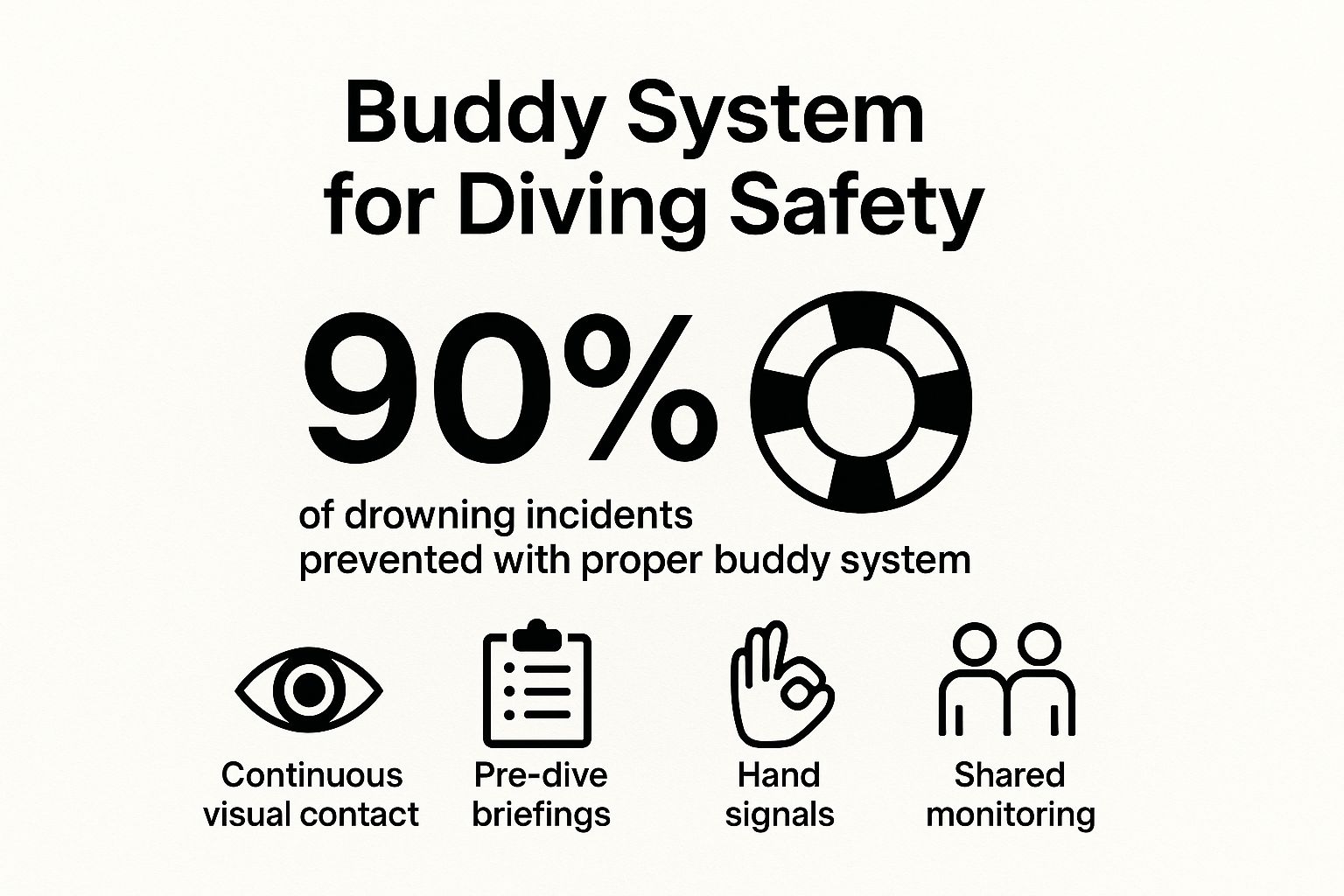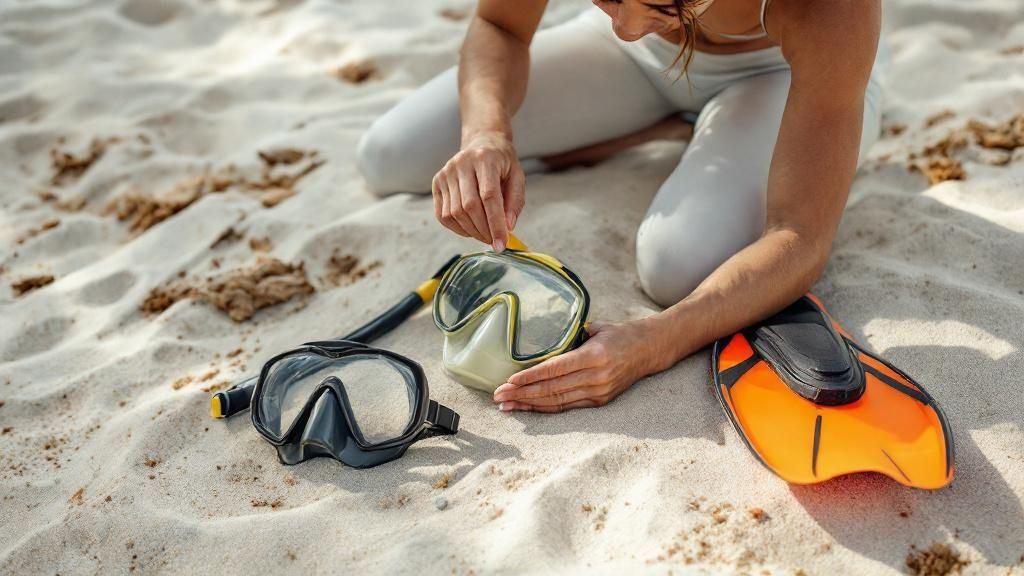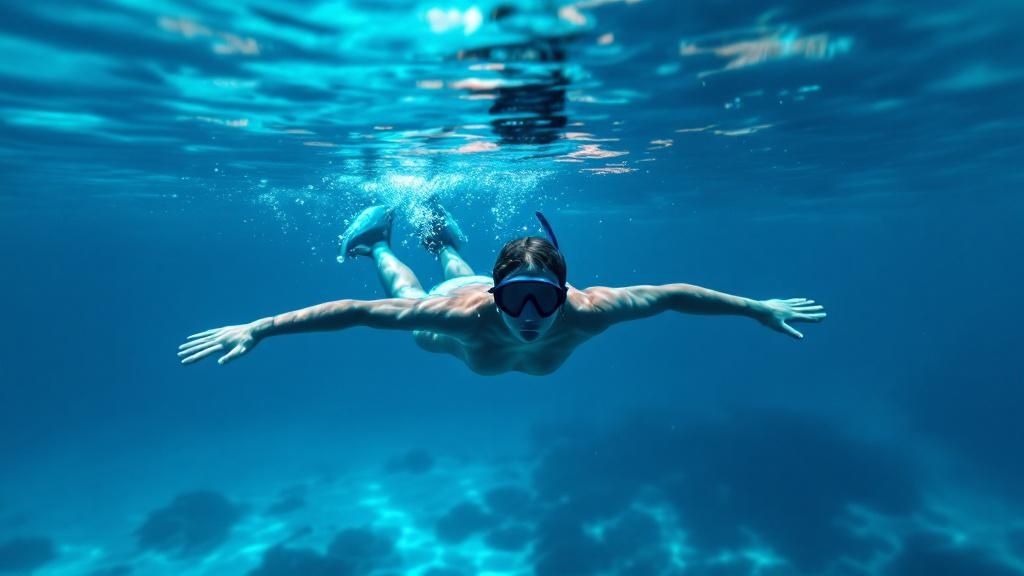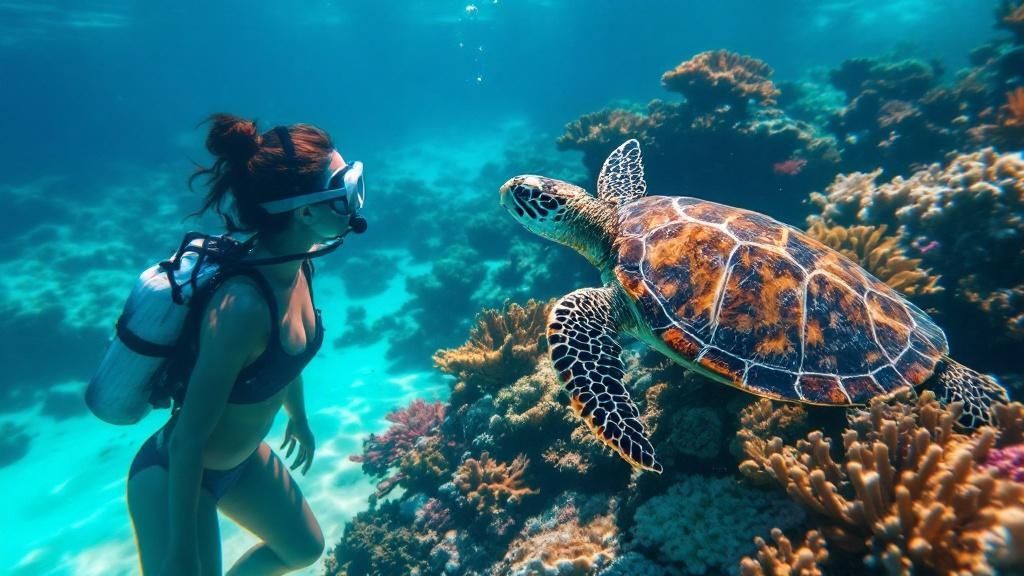Top Snorkeling Safety Tips for a Safe Underwater Experience

Snorkeling offers a breathtaking window into vibrant underwater ecosystems, a chance to float effortlessly among colorful fish and intricate coral reefs. While it's one of the most accessible water activities, this accessibility can sometimes create a false sense of security. The difference between a magical experience and a potential emergency often comes down to knowledge and preparation. These are not just generic pointers; they are a comprehensive set of snorkeling safety tips designed to empower you, whether you're exploring calm coves or venturing into new waters.
From pre-dive gear rituals to understanding the subtle language of the ocean, mastering these practices ensures your focus remains on the beauty around you, not on avoidable risks. This guide will delve deep into the critical aspects of safety, providing actionable advice that even seasoned snorkelers will find invaluable. We'll cover everything from the non-negotiable buddy system and proper equipment fitting to advanced techniques for managing buoyancy and respecting marine wildlife.
Understanding these specific water-based precautions is a key part of your travel preparations. Just as you would plan other aspects of your trip, incorporating broader practices for general holiday safety ensures a seamless and secure experience from start to finish. By combining overall travel awareness with specialized knowledge for your activities, you create a robust safety net. This list will equip you with the essential skills to transform your approach to snorkeling from a casual dip to a confident, safe, and truly immersive exploration. Prepare to unlock the underwater world with the peace of mind you deserve.
1. Master the Buddy System: Your First Line of Defense in the Water
The single most important of all snorkeling safety tips is to never, ever snorkel alone. The buddy system, a cornerstone of water safety championed by organizations like PADI and the Red Cross, is a non-negotiable pact. It transforms a solo exploration into a team effort, creating a vital safety net where you and a partner are mutually responsible for each other's well-being.
Your buddy is your immediate lifeline. They are the first to notice if you are struggling, experiencing an equipment malfunction, or facing a medical issue like cramping or fatigue. In an emergency, they can provide direct assistance or, crucially, signal for help. This simple partnership drastically reduces the risk of a minor problem escalating into a serious incident.
How to Implement the Buddy System Effectively
Merely entering the water with another person isn't enough; true buddy system proficiency requires a proactive approach. Before you even get your feet wet, establish a clear plan.
- Partner Selection: Choose a buddy with a similar or stronger swimming ability. This ensures you can keep pace with each other and that one person won't be struggling to catch up.
- Pre-Snorkel Briefing: Agree on your route, how long you plan to be in the water, and how far apart you will stay. A good rule of thumb is to remain close enough to reach your partner within a few seconds.
- Communication Plan: Establish simple, clear hand signals. Common signals include "OK" (forming a circle with your thumb and index finger), "problem" (waving a flat hand), and "let's go up" (thumbs-up gesture).
- Separation Protocol: Decide what to do if you get separated. The standard procedure is to look for your buddy for no more than one minute, then surface safely to re-establish visual contact.
This infographic highlights the statistical impact and core components of a properly executed buddy system.

The data clearly illustrates that this isn't just a suggestion; it's a proven life-saving strategy that relies on clear communication and constant awareness.
Key Insight: The buddy system is not a passive activity. It requires active monitoring, clear pre-dive communication, and a shared commitment to returning to shore together safely. Think of your buddy as an extension of your own awareness.
2. Proper Equipment Inspection and Fitting: Your Gear is Your Lifeline
Before you can safely explore the underwater world, you must trust the gear that allows you to do so. A thorough equipment inspection and proper fitting process is a critical snorkeling safety tip that prevents the most common and avoidable problems. Gear failure, from a leaky mask to a cracked snorkel, can quickly lead to panic and water inhalation. Brands like Cressi and Mares have built their reputations on reliable gear, but even the best equipment requires user diligence.

This pre-snorkel ritual, mandatory in professional settings from military diving to guided tours, ensures your mask, snorkel, and fins function as intended. A poorly sealed mask will constantly fill with water, distracting you and causing stress. Ill-fitting fins can cause painful blisters or fall off, leaving you struggling to swim. Taking a few minutes on shore to perform these checks is a small investment that pays huge dividends in safety and enjoyment. For more in-depth advice, you can learn more about the gear for snorkeling in a top destination like Hawaii.
How to Implement Proper Gear Checks
A systematic check ensures no component is overlooked. Follow this professional-grade protocol before every single time you enter the water to build a strong safety habit.
- Mask Seal Test: Place the mask against your face without using the strap. Inhale gently through your nose. If the mask creates a vacuum and stays in place, you have a good seal. If it falls off, it will leak, so adjust its position or try a different mask.
- Snorkel Inspection: Examine the snorkel tube for any cracks. Check that the mouthpiece is secure and the purge valve (if present) is clear of sand and debris. Bite down gently on the mouthpiece to ensure it’s comfortable.
- Fin Fit Check: Your fins should fit snugly like a comfortable shoe, without pinching or cramping your toes. If using full-foot fins, there should be no significant gaps at the heel. For open-heel fins, ensure the straps are secure and not worn out.
- General Wear and Tear: Look over all straps, buckles, and plastic components for signs of sun damage, cracking, or brittleness. Rinsing gear with fresh water after each use significantly extends its life.
Beyond your personal gear, understanding what other essential water safety equipment is available can round out your preparedness for any aquatic activity.
Key Insight: Your snorkeling gear is not just for comfort; it's life-support equipment. Treating your pre-snorkel inspection with the seriousness of a pilot's pre-flight check transforms a potential liability into a reliable safety tool.
3. Know Your Swimming Limits and Conditions
One of the most foundational snorkeling safety tips is to conduct an honest and realistic assessment of both your personal abilities and the environment you're about to enter. Many preventable incidents occur when snorkelers overestimate their swimming strength or underestimate the power of the ocean. Acknowledging your limits is not a sign of weakness; it's a mark of a smart and responsible adventurer.
This principle involves two critical parts: self-awareness and environmental awareness. You must understand your physical fitness, comfort in open water, and swimming proficiency. Simultaneously, you need to evaluate the day's specific conditions, such as currents, waves, visibility, and weather, as championed by organizations like Surf Life Saving Australia and the United States Lifesaving Association.
How to Assess and Adapt to Your Environment
Properly evaluating conditions and your readiness is an active process that begins before you ever touch the water. It ensures you don’t find yourself in a situation that is beyond your control.
- Honest Skill Assessment: Be truthful about your swimming ability. Can you comfortably swim 200-300 meters without stopping? Are you comfortable treading water? If not, stick to very shallow, calm, and supervised areas.
- Check Official Forecasts: Before heading out, consult local marine forecasts and beach condition reports. Services like those in Australia and Hawaii provide invaluable, up-to-date information on tides, surf, and potential hazards.
- On-Site Observation: Spend a few minutes observing the water from the shore. Look for the direction of the current, the size and frequency of waves, and any visible rip currents. If the water looks rough or chaotic, it's best to wait for another day.
- Start Small: Always begin your snorkel in shallow water to acclimate and test your comfort level. This gives you a chance to adjust your equipment and get a feel for the water's movement before committing to deeper areas. For longer snorkeling sessions, it's wise to consider strategies to improve your stamina, ensuring you always have enough energy to return safely.
Understanding the direct link between physical fitness and safe snorkeling is crucial. For more details on preparing your body for the activity, you can learn more about snorkeling and fitness on konasnorkeltrips.com.
Key Insight: The ocean is a dynamic environment that can change rapidly. Your safety depends on respecting its power and making conservative choices based on a realistic understanding of your personal capabilities. Never let ambition or peer pressure push you beyond your comfort zone.
4. Master Proper Breathing Techniques: Your Key to Calm and Control
Your ability to breathe calmly and effectively through a snorkel is the foundation of a safe and enjoyable underwater experience. Panic and shortness of breath are significant contributors to snorkeling incidents, but they are almost always preventable. Mastering proper breathing techniques transforms snorkeling from a potentially stressful activity into a meditative exploration, conserving your energy and keeping your mind clear.
Proper breathing involves slow, deep, and deliberate breaths through the snorkel tube, not short, shallow gasps. This efficient exchange of air prevents the buildup of carbon dioxide, which can trigger the panicked feeling of needing air. Learning to control your breath, especially when clearing your snorkel, is one of the most vital snorkeling safety tips you can practice.
How to Implement Proper Breathing Techniques
Becoming a confident breather in the water requires practice and a calm mindset. Before heading into deeper water, spend time in a shallow, controlled environment to build your skills.
- Practice in Shallow Water: Stand or kneel in calm, shallow water where you can easily stand up. Place your face in the water and focus on taking slow, relaxed breaths through the snorkel. Get comfortable with the sensation.
- Learn the Blast Clear: The "blast clear" is the most effective way to expel water from your snorkel tube. If water enters your snorkel, take the remaining air in your lungs and exhale forcefully, like a whale spouting. This blast of air will shoot the water out of the top of the tube.
- Avoid Hyperventilation: Never intentionally take a series of rapid, deep breaths (hyperventilate) before holding your breath to dive down. This practice can dangerously trick your body into delaying its signal to breathe, increasing the risk of a shallow water blackout.
- Surface Calmly: If you ever feel short of breath or anxious, the solution is simple: stop, lift your head out of the water, and breathe normally. Never push through the feeling of air hunger.
This video from PADI provides a great visual demonstration of key breathing and snorkel clearing methods.
The techniques demonstrated here are fundamental. Mastering them turns potential panic situations into minor, manageable events. For an in-depth guide, you can learn more about how to breathe when snorkeling.
Key Insight: Your breath is your anchor to calmness in the water. Control your breathing, and you control your experience. Practice isn't just about technique; it's about building the muscle memory and mental confidence to remain relaxed when faced with a minor challenge like a flooded snorkel.
5. Address Sun and Temperature Extremes: Your Environmental Shield
Snorkelers often focus so much on the world below the surface that they forget about the powerful environmental forces above and around them: the sun and the water temperature. One of the most overlooked yet crucial snorkeling safety tips is to actively manage your exposure to both UV radiation and cold. The water's surface acts like a giant mirror, intensifying the sun's rays, while your body loses heat up to 25 times faster in water than in air, making both sunburn and hypothermia significant risks.
Protecting yourself is not just about comfort; it's about preventing serious health issues. Severe sunburn can lead to sun poisoning, while hypothermia can impair judgment and physical ability, turning a beautiful day into a dangerous situation. Proactive protection ensures you can extend your time in the water safely and enjoyably, focusing on the marine life instead of physical distress.
How to Mitigate Environmental Risks Effectively
A dual-pronged strategy is necessary to shield yourself from both the sun's intensity and the water's chilling effect. This requires more than just a quick application of sunscreen; it demands conscious preparation and in-water awareness.
- UV Protection Strategy: The sun's reflection off the water dramatically increases your exposure. Wear a high-SPF (30+), broad-spectrum, reef-safe sunscreen to protect both your skin and delicate coral ecosystems. Even better, cover up with a long-sleeved rash guard and snorkeling leggings. This physical barrier is more effective and doesn't wash off. A wide-brimmed hat and polarized sunglasses for your time out of the water are also essential.
- Thermal Regulation Plan: Even in tropical waters hovering around 80°F (27°C), your body will slowly lose heat. For longer snorkeling sessions, a thin wetsuit or a thermal rash guard can make a huge difference. Pay attention to your body. Uncontrollable shivering is the first and most obvious sign of hypothermia and a clear signal to get out of the water, dry off, and warm up immediately.
- Monitor and Manage: Take regular breaks out of the water, preferably in the shade. Use this time to rehydrate with fresh water (not just sugary drinks) and reapply sunscreen. This allows your body to warm up and gives you a chance to assess how you are feeling. For a complete overview of best practices, you can learn more about a comprehensive snorkeling UV protection guide.
This approach is standard practice in professional operations. For instance, tour operators on the Great Barrier Reef often require reef-safe sunscreen, while cold-water adventure companies make thermal gear mandatory.
Key Insight: Your skin is your largest organ, and your body's core temperature is central to your survival. Treat sun and cold protection not as an option, but as a core piece of your snorkeling equipment. Proper gear is your best defense against these invisible environmental threats.
6. Maintain Proper Buoyancy and Body Position: The Key to Effortless Snorkeling
One of the most overlooked yet critical snorkeling safety tips is mastering your buoyancy and body position. This skill, fundamental in practices from scuba diving to military water survival training, is about achieving a state of effortless flotation. Proper technique allows you to conserve immense amounts of energy, move efficiently, and observe marine life without disturbing it or putting yourself at risk.

Poor buoyancy control is a leading cause of exhaustion and panic for beginners. Thrashing to stay afloat, kicking vertically, or struggling to maintain position burns through energy reserves quickly. By learning to float horizontally and use gentle propulsion, you transform a strenuous activity into a relaxing glide, significantly enhancing both your safety and enjoyment. This principle was championed by pioneers like Jacques Cousteau, who understood that becoming one with the water was essential for underwater exploration.
How to Implement Proper Buoyancy and Body Position
Adopting the right posture and mindset is key. Before venturing into deeper water, dedicate time to practicing these techniques in a calm, shallow area where you can stand up easily.
- Practice Floating: Begin by simply lying face down in the water, allowing your body to relax completely. Take slow, deep breaths through your snorkel. Notice how your lungs act as a natural flotation device; a full inhale will lift you slightly, while an exhale will lower you.
- Maintain a Horizontal Profile: Keep your body as flat and parallel to the surface as possible. This streamlined position, similar to that used in competitive swimming, minimizes drag and makes movement almost effortless. Avoid the common mistake of swimming with your head up and legs down, which creates resistance and wastes energy.
- Use Gentle Fin Kicks: Your power should come from your hips, not your knees. Use slow, deliberate, and full kicks with your fins. Rapid, splashy movements are inefficient and can stir up sand, reducing visibility and disturbing the ecosystem.
- Relax Completely: Tension is the enemy of buoyancy. Tense muscles sink. Consciously relax your neck, shoulders, and limbs. Trust your gear and your natural ability to float.
This mastery of movement not only prevents fatigue but also protects the delicate marine environment. By staying horizontal and in control, you avoid accidentally kicking or standing on fragile coral reefs or startling marine life.
Key Insight: Proper buoyancy is less about active swimming and more about controlled relaxation. By mastering a horizontal, streamlined position and breathing calmly, you conserve energy, reduce panic risk, and become a respectful observer of the underwater world rather than an intrusive visitor.
7. Respect Marine Life and Environmental Hazards: Your Guide to Coexisting Safely
One of the most profound joys of snorkeling is witnessing an underwater ecosystem in its natural state. However, entering this world requires you to be a respectful guest, not an intruder. A key component of snorkeling safety tips involves understanding that the ocean is a wild environment, filled with both delicate life and potential hazards. Protecting yourself often means protecting the environment around you.
This principle, championed by organizations like the Ocean Conservancy and National Geographic, is based on a dual awareness: recognizing and respecting marine creatures while simultaneously identifying and avoiding environmental dangers. Many preventable injuries occur not from aggressive animals, but from accidental contact with defensive ones or by underestimating the power of the ocean itself.

How to Practice Environmental Awareness and Respect
Adopting a "look, don't touch" philosophy is the foundation of safe and ethical snorkeling. This proactive mindset protects both you and the fragile marine habitats you've come to admire. Before your trip, research the specific environment you'll be visiting.
- Maintain a Safe Distance: The golden rule is to never touch, chase, or corner any marine animal. For larger creatures like sea turtles or rays, maintain a distance of at least 10 feet (3 meters). This prevents stressing the animal and reduces the risk of a defensive reaction.
- Identify Local Species: Learn to recognize potentially venomous or defensive creatures in your area, such as stonefish, lionfish, or certain types of jellyfish. Knowledge is your best defense, allowing you to admire them from a safe distance.
- Mind the Coral: Never stand on or touch coral reefs. They are living colonies of tiny, fragile animals, and contact can damage them permanently and cause nasty cuts and scrapes for you. Maintain neutral buoyancy to float above the reef.
- Assess Environmental Conditions: Be aware of currents, tides, and potential underwater obstacles like rocks or submerged structures. If you see signs of a strong current (like water moving quickly past a buoy), it may be best to choose a more sheltered location. This guide on how to Respect Marine Life and Environmental Hazards offers further details.
Successful conservation programs, from the Great Barrier Reef to the Caribbean, integrate snorkeler education as a core component, proving that informed visitors are the safest visitors.
Key Insight: Your safety is directly linked to the health and well-being of the marine environment. By actively respecting boundaries and understanding natural hazards, you minimize your risk and ensure the underwater world remains pristine for future generations.
8. Emergency Preparedness and Communication: Your Plan for the Unexpected
Even with perfect technique and the best equipment, unforeseen situations can arise. This is where emergency preparedness and communication become critical snorkeling safety tips, transforming a potential crisis into a manageable event. Championed by safety organizations like the Divers Alert Network (DAN) and the United States Coast Guard, this proactive mindset involves creating a clear plan for what to do when things go wrong.
A well-defined emergency plan is your roadmap to safety in a high-stress situation. It ensures that everyone involved, both in the water and on shore, knows their role and the correct procedures to follow. This preparation minimizes panic, reduces response time, and drastically improves the outcome of any incident, from a minor gear issue to a serious medical emergency.
How to Implement an Effective Emergency Plan
A robust emergency plan extends beyond just knowing who to call. It requires thoughtful preparation before you even approach the water, creating a safety net that covers multiple contingencies.
- Appoint Shore Support: Always tell someone on land where you are going and when you expect to be back. This person is your shore support. Give them a "panic time" – a specific time to call for help if they haven't heard from you.
- Carry Signaling Devices: A simple, waterproof whistle attached to your BCD or wrist is a powerful tool. Its high-pitched sound travels much farther over water than your voice. A signal mirror or a brightly colored safety sausage (SMB – Surface Marker Buoy) also significantly increases your visibility to boats and rescuers.
- Know Local Emergency Contacts: Before your trip, save the local equivalent of 911 and the number for the local coast guard or marine rescue in your phone. Keep these numbers written on a waterproof card as a backup.
- Learn Basic Rescue Skills: Understanding basic water rescue techniques, like how to assist a tired swimmer without endangering yourself, is invaluable. Many organizations, like the Red Cross, offer courses that provide these essential skills.
This system of layered preparedness ensures you have multiple ways to signal for and receive help. It acknowledges that technology can fail and that a low-tech whistle can be just as lifesaving as a phone call.
Key Insight: Emergency preparedness is not about expecting the worst; it's about empowering yourself to handle it. A simple, well-communicated plan and the right signaling tools can make all the difference when seconds count.
Snorkeling Safety Tips Comparison Guide
| Safety Practice | Implementation Complexity 🔄 | Resource Requirements ⚡ | Expected Outcomes 📊 | Ideal Use Cases 💡 | Key Advantages ⭐ |
|---|---|---|---|---|---|
| Buddy System and Supervision | Low to Moderate 🔄 | Minimal (partner coordination) ⚡ | High safety, immediate emergency aid 📊 | All water activities, especially open water | Immediate assistance, panic reduction, shared safety responsibility ⭐ |
| Proper Equipment Inspection and Fitting | Moderate 🔄 | Moderate (time, knowledge, gear) ⚡ | Reduced equipment failure, comfort 📊 | Pre-dive checks, rental or new gear users | Prevents gear-related accidents, enhances performance ⭐ |
| Know Your Swimming Limits and Conditions | Low to Moderate 🔄 | Minimal (self & environment assessment) ⚡ | Lower accident risk, better site choice 📊 | Recreational snorkeling, variable conditions | Prevents overexertion, improves planning, risk reduction ⭐ |
| Master Proper Breathing Techniques | Moderate to High 🔄 | Low (practice) ⚡ | Reduced panic, extended snorkeling time 📊 | Novices, freedivers, long-duration snorkeling | Anxiety reduction, energy conservation, breathing control ⭐ |
| Sun Protection and Hypothermia Prevention | Low 🔄 | Moderate (sunscreen, clothing, breaks) ⚡ | Prevents sunburn, hypothermia 📊 | Extended snorkeling sessions, sunny/cold water | Prolonged comfort, health protection, skin cancer risk reduction ⭐ |
| Maintain Proper Buoyancy and Body Position | Moderate 🔄 | Low (practice, may need weight adjustment) ⚡ | Energy saving, environmental protection 📊 | All snorkelers, beginners to advanced | Fatigue reduction, better observation, coral protection ⭐ |
| Respect Marine Life and Environmental Hazards | Moderate 🔄 | Moderate (knowledge, training) ⚡ | Injury prevention, ecosystem protection 📊 | Sensitive environments, wildlife-rich sites | Injury avoidance, conservation, enhanced wildlife experience ⭐ |
| Emergency Preparedness and Communication | Moderate to High 🔄 | Moderate to High (equipment, planning) ⚡ | Faster, effective emergency response 📊 | Remote sites, group excursions, professional tours | Reduces accident severity, supports rescue, peace of mind ⭐ |
Your Journey to Becoming a Confident, Safe Snorkeler
The underwater world offers a spectacle of unparalleled beauty, a vibrant ecosystem brimming with life and color. Venturing into this realm is a privilege, and doing so safely is a responsibility we owe to ourselves and the ocean. The extensive list of snorkeling safety tips we've explored is not meant to intimidate, but to empower. Think of these guidelines not as a restrictive set of rules, but as your personal toolkit for building unshakable confidence in the water.
Each tip is a stepping stone. Mastering your gear check transforms you from a passive participant into a proactive explorer. Understanding and respecting your physical limits isn't a sign of weakness; it's a mark of wisdom that ensures longevity in your snorkeling adventures. By embracing these principles, you are actively crafting a safer, more enriching experience every time you slip on your fins.
From Rules to Instincts: Internalizing Safety
The ultimate goal is to move beyond simply remembering these tips to having them become second nature. True mastery is achieved when safety becomes an instinctual part of your pre-snorkel routine. It’s about creating a mental checklist that runs automatically.
- Before You Go: You’ll instinctively glance at the weather forecast and tide charts. You'll grab your reef-safe sunscreen and hydration without a second thought.
- At the Water's Edge: Your hands will naturally inspect the silicone skirt of your mask and test the buckle on your fins. You'll automatically discuss hand signals and a return plan with your buddy.
- In the Water: You will find yourself naturally maintaining a safe distance from coral, positioning your body horizontally, and breathing with a calm, rhythmic pattern that conserves energy and maximizes your bottom time.
This transition from conscious effort to subconscious habit is where the real magic happens. It frees your mind from worry, allowing you to become fully present and immersed in the breathtaking scenery around you. You stop thinking about being a safe snorkeler and simply become one.
The Core Pillars of Snorkeling Confidence
While every tip we covered holds value, a few core pillars form the foundation of every safe and memorable underwater journey. If you take anything away from this guide, let it be these key concepts:
- Situational Awareness: This is the master skill. It encompasses everything from checking the weather and currents (Know Your Conditions) to keeping an eye on your buddy (Buddy System) and being mindful of your position relative to boats, shore, and marine life (Respect the Environment).
- Equipment Proficiency: Your gear is your life support system. A leaky mask or a faulty snorkel can quickly turn a pleasant swim into a stressful situation. Committing to a thorough pre-snorkel inspection (Proper Equipment Check) is non-negotiable.
- Calmness is Key: Panic is the enemy of safety. Every technique, from mastering your breathing (Breathing Techniques) to knowing your emergency plan (Emergency Preparedness), is designed to prevent panic. A calm mind makes better decisions, conserves oxygen, and allows you to solve problems effectively.
By focusing on these three pillars, you build a resilient framework for safety. You become an asset to yourself and your snorkeling partners, capable of navigating the marine environment with respect and self-assurance. This proactive mindset is the most critical piece of equipment you will ever own, ensuring that your memories are filled with the wonder of the ocean, not the anxiety of a preventable incident. Embrace this journey of knowledge, and you will unlock a lifetime of incredible, safe underwater exploration.
Ready to put these skills into practice in one of the world's premier snorkeling destinations? For a truly unforgettable and safe experience in Hawaii, let the experts at Kona Snorkel Trips guide you. Their certified crew handles all the safety logistics, from professional-grade gear to expert briefings and in-water supervision, so you can focus entirely on the magic of swimming with manta rays and exploring pristine coral reefs. Visit Kona Snorkel Trips to book your adventure today
